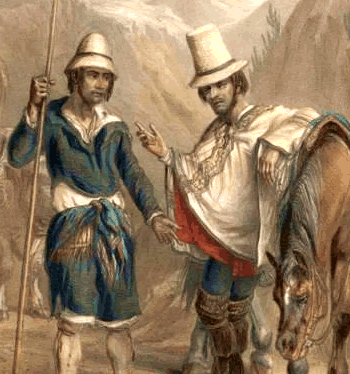|
Eugenio Pereira Salas
Eugenio Pereira Salas (May 19, 1904 - November 17, 1979) was a Chilean historian. Works *''The origins of Musical Art in Chile'' (1941) *''Colonial Games and Joys in Chile'' (1947) *''Notes on the History of Chilean Cuisine'' (1943) *''Bibliographical Guide to the Study of Chilean Folklore'' (1952) *''Pepe Vila. The Zarzuela Girl in Chile'' (1952) *''South America. Peru - Bolivia - Paraguay - Argentina - Chile''. National Period (1956) *''History of Music in Chile'' (1850 - 1900) (1957) *''Art History in the Kingdom of Chile'' (1965) *''The First Contacts Between Chile and the United States'', 1778 - 1808 (1971) *''Theatre History in Chile From its Origins to the Death of John Casacuberta, one thousand eight hundred forty-eight'' (1974) *''Notes on the History of Chilean Cuisine'' (1977) *''Biobibliography Musical Backgrounds into Chile from 1886'' (1978) *''Research on the History of Art in Chile Republican'' (1992, posthumous Posthumous may refer to: * Posthumous award - a ... [...More Info...] [...Related Items...] OR: [Wikipedia] [Google] [Baidu] |
Chile
Chile, officially the Republic of Chile, is a country in the western part of South America. It is the southernmost country in the world, and the closest to Antarctica, occupying a long and narrow strip of land between the Andes to the east and the Pacific Ocean to the west. Chile covers an area of , with a population of 17.5 million as of 2017. It shares land borders with Peru to the north, Bolivia to the north-east, Argentina to the east, and the Drake Passage in the far south. Chile also controls the Pacific islands of Juan Fernández, Isla Salas y Gómez, Desventuradas, and Easter Island in Oceania. It also claims about of Antarctica under the Chilean Antarctic Territory. The country's capital and largest city is Santiago, and its national language is Spanish. Spain conquered and colonized the region in the mid-16th century, replacing Inca rule, but failing to conquer the independent Mapuche who inhabited what is now south-central Chile. In 1818, after declaring in ... [...More Info...] [...Related Items...] OR: [Wikipedia] [Google] [Baidu] |
Historian
A historian is a person who studies and writes about the past and is regarded as an authority on it. Historians are concerned with the continuous, methodical narrative and research of past events as relating to the human race; as well as the study of all history in time. Some historians are recognized by publications or training and experience.Herman, A. M. (1998). Occupational outlook handbook: 1998–99 edition. Indianapolis: JIST Works. Page 525. "Historian" became a professional occupation in the late nineteenth century as research universities were emerging in Germany and elsewhere. Objectivity During the ''Irving v Penguin Books and Lipstadt'' trial, people became aware that the court needed to identify what was an "objective historian" in the same vein as the reasonable person, and reminiscent of the standard traditionally used in English law of "the man on the Clapham omnibus". This was necessary so that there would be a legal benchmark to compare and contrast the scholar ... [...More Info...] [...Related Items...] OR: [Wikipedia] [Google] [Baidu] |
Chilean Music
Chilean music refers to all kinds of music developed in Chile, or by Chileans in other countries, from the arrival of the Spanish conquistadors to the modern day. It also includes the native pre-Columbian music from what is today Chilean territory. Music in Chile Pre-Columbian and colonial times Prior to the arrival of the European conquerors, the modern national borders that make up the Americas did not exist, so one cannot refer to music from "Chile", or any other South American country, from this time. However, music existed in the Americas for centuries before European conquest, and many of the characteristics and instruments of pre-Hispanic music have formed part of the folkloric and musical tradition of Chile and of Latin America. Archaeological excavations have unearthed many musical instruments showing the existence of a variety of musical cultures in the area long before even the Inca period. Scientific research into remains left by the Nazca and Mochica peoples has ... [...More Info...] [...Related Items...] OR: [Wikipedia] [Google] [Baidu] |
Chilean People
Chileans ( es, Chilenos) are people identified with the country of Chile, whose connection may be residential, legal, historical, ethnic, or cultural. For most Chileans, several or all of these connections exist and are collectively the source of their Chilean identity. Chile is a multilingual and multicultural society, but an overwhelming majority of Chileans have Spanish as their first language and either are Christians or have a Christian cultural background. Therefore, many Chileans do not equate their nationality with ethnicity, but with citizenship and allegiance to Chile. The overwhelming majority of Chileans are the product of varying degrees of admixture between European ethnic groups (predominantly Spaniards and Basques) with peoples indigenous to Chile's modern territory (predominantly Mapuche). Although the historic mestizaje of Europeans and Amerindians is evident across all social strata in the Chilean population, there is a strong correlation between the ratio ... [...More Info...] [...Related Items...] OR: [Wikipedia] [Google] [Baidu] |
Chilean Cuisine
Chilean cuisine stems mainly from the combination of traditional Spanish cuisine, Chilean Mapuche culture and local ingredients, with later important influences from other European cuisines, particularly from Germany, the United Kingdom and France. The food tradition and recipes in Chile are notable for the variety of flavours and ingredients, with the country's diverse geography and climate hosting a wide range of agricultural produce, fruits and vegetables. The long coastline and the peoples' relationship with the Pacific Ocean add an immense array of seafood to Chilean cuisine, with the country's waters home to unique species of fish, molluscs, crustaceans and algae, thanks to the oxygen-rich water carried in by the Humboldt Current. Chile is also one of the world's largest producers of wine and many Chilean recipes are enhanced and accompanied by local wines. The confection dulce de leche was invented in Chile and is one of the country's most notable contributions to worl ... [...More Info...] [...Related Items...] OR: [Wikipedia] [Google] [Baidu] |
Folklore
Folklore is shared by a particular group of people; it encompasses the traditions common to that culture, subculture or group. This includes oral traditions such as tales, legends, proverbs and jokes. They include material culture, ranging from traditional building styles common to the group. Folklore also includes customary lore, taking actions for folk beliefs, the forms and rituals of celebrations such as Christmas and weddings, folk dances and initiation rites. Each one of these, either singly or in combination, is considered a folklore artifact or traditional cultural expression. Just as essential as the form, folklore also encompasses the transmission of these artifacts from one region to another or from one generation to the next. Folklore is not something one can typically gain in a formal school curriculum or study in the fine arts. Instead, these traditions are passed along informally from one individual to another either through verbal instruction or demonstr ... [...More Info...] [...Related Items...] OR: [Wikipedia] [Google] [Baidu] |
Zarzuela
() is a Spanish lyric-dramatic genre that alternates between spoken and sung scenes, the latter incorporating operatic and popular songs, as well as dance. The etymology of the name is uncertain, but some propose it may derive from the name of a royal hunting lodge, the Palace of Zarzuela, near Madrid, where that type of entertainment was allegedly first presented to the court. The palace in turn was named after the brambles () that grew there. There are two main forms of ''zarzuela'': Baroque ''zarzuela'' (c. 1630–1750), the earliest style, and Romantic ''zarzuela'' (c. 1850–1950). Romantic zarzuelas can be further divided into two main subgenres, ''género grande'' and ''género chico'', although other sub-divisions exist. ''Zarzuela'' spread to the Spanish dominions, and many Spanish-speaking countries – notably Cuba – developed their own traditions. ''Zarzuela'' is also a strong tradition in the Philippines, where it is also referred to in certain ... [...More Info...] [...Related Items...] OR: [Wikipedia] [Google] [Baidu] |
Art History
Art history is the study of aesthetic objects and visual expression in historical and stylistic context. Traditionally, the discipline of art history emphasized painting, drawing, sculpture, architecture, ceramics and decorative arts; yet today, art history examines broader aspects of visual culture, including the various visual and conceptual outcomes related to an ever-evolving definition of art. Art history encompasses the study of objects created by different cultures around the world and throughout history that convey meaning, importance or serve usefulness primarily through visual representations. As a discipline, art history is distinguished from art criticism, which is concerned with establishing a relative artistic value upon individual works with respect to others of comparable style or sanctioning an entire style or movement; and art theory or "philosophy of art", which is concerned with the fundamental nature of art. One branch of this area of study is aesthetics, wh ... [...More Info...] [...Related Items...] OR: [Wikipedia] [Google] [Baidu] |
Chilean Art
Chilean art refers to all kinds of visual art developed in Chile, or by Chileans, from the arrival of the Spanish conquerors to the modern day. It also includes the native pre-Columbian pictorial expression on modern Chilean territory. Pre-Columbian art Prehistoric painting in Chile, also called pre-Columbian Chilean painting, refers to any type of painting or painting technique used to represent objects or people during the period before the Spanish conquest. Developed prior to the existence of written sources, study of this period is based on the material remains and vestiges of the cultures that developed. The beginning of pre-Columbian art in Chile coincided with the appearance of indigenous cultures in the territory, and ended around the start of the Spanish conquest of Chile around 1500AD. After this period, indigenous art was virtually eliminated by the Catholic community as part of the process of converting native people. (see also: Catholic Church and the Age of Disco ... [...More Info...] [...Related Items...] OR: [Wikipedia] [Google] [Baidu] |
Chile - US Relations
Chile, officially the Republic of Chile, is a country in the western part of South America. It is the southernmost country in the world, and the closest to Antarctica, occupying a long and narrow strip of land between the Andes to the east and the Pacific Ocean to the west. Chile covers an area of , with a population of 17.5 million as of 2017. It shares land borders with Peru to the north, Bolivia to the north-east, Argentina to the east, and the Drake Passage in the far south. Chile also controls the Pacific islands of Juan Fernández, Isla Salas y Gómez, Desventuradas, and Easter Island in Oceania. It also claims about of Antarctica under the Chilean Antarctic Territory. The country's capital and largest city is Santiago, and its national language is Spanish. Spain conquered and colonized the region in the mid-16th century, replacing Inca rule, but failing to conquer the independent Mapuche who inhabited what is now south-central Chile. In 1818, after declaring inde ... [...More Info...] [...Related Items...] OR: [Wikipedia] [Google] [Baidu] |
Posthumous Recognition
A posthumous award is granted after the recipient has died. Many prizes, medals, and awards can be granted posthumously. Australian actor Heath Ledger, for example, won many awards after his death in 2008. Military decorations, such as Hero of the Russian Federation or the Medal of Honor, are often given posthumously. During World War II, many countries practiced the granting of posthumous awards. Sports awards and titles can be awarded posthumously, for example 1970 Formula One champion Jochen Rindt, who died in a crash late in the season, but still had enough points to be named champion. Less commonly, certain prizes, medals, and awards are granted ''only'' posthumously, especially those that honor people who died in service to a particular cause. Such awards include the Confederate Medal of Honor award, to Confederate veterans who distinguished themselves conspicuously during the American Civil War (1861–1865), and the Dag Hammarskjöld Medal, to military personnel, polic ... [...More Info...] [...Related Items...] OR: [Wikipedia] [Google] [Baidu] |






